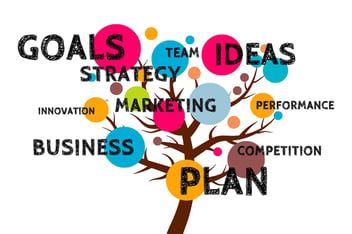Avoid These Startup Marketing Mistakes | 8 Tips for Your Startup
You've just launched your marketing department for your shiny new startup, and at this point, it consists of yourself, a developer who also writes, and someone from admin. This is a recipe for potential marketing nightmares, right? Not necessarily.
Marketing for startups doesn't have to be scary, and it doesn't have to eat a gaping hole in your first-round funding. As long as you avoid some pitfalls, you can bootstrap your marketing to get the word out and set yourself up for a secure source of future customers. Here are eight all-too-common mistakes you'll want to steer clear of.
1) Thinking you don't need a plan
Do you know that business plan you had to have in place to secure funding? Pretty important, huh? What about your marketing plan? Marketing plans are just as important, yet they get overlooked often.
This is where you lay out your content marketing strategy and social media outlook, along with your traditional marketing (contrary to what you might have heard, print is decidedly NOT dead). This is where you'll store your target personas so you can reference them in the future to make tweaks and ensure your new strategies take them into account.
Think of your marketing plan as the blueprint for the marketing empire you will build. Having the framework set out now means that when you create an actual marketing department, they'll know where to pick up.
2) Seeking the spotlight too soon
There have been several catastrophic startup meltdowns recently. Look at a news roundup of the last few years, and you'll see some familiar names peppered throughout, usually with the words "failure," "meltdown," “oversight," and the like. Juicero and Theranos are the two that stand out, and they share something else in common—they both went after the media spotlight before they had a solid product.
There's a reasonably simple solution to avoiding this scenario, do your research. This will become a theme throughout this article. For this entry, the bottom line is to be sure you have a solid background in your product market (and a working model wouldn't hurt) BEFORE you start issuing press releases and holding press conferences.
3) Producing One-Size-Fits-All Content
There are dozens of channels online through which you can market yourself and your new widget, and contrary to a commonly held belief in the tech world, you can't be everything to everyone. So why are you only producing one content type?
Tailor your content to the sub-target persona you've identified as your audience on each platform. That theme of "do your research" applies here. Put in the time early to identify your general target customer persona, then tailor it to sub-target personas for each channel you use. Now you can tailor your content for direct hits to the right audience, meaning better conversion rates for your efforts.
4) Marketing on the wrong channels
Directly related to mistake #3 is marketing on the wrong channels. You're a startup, and you and your team have limited time, energy, and (likely) budget to make this marketing thing work for you. Is your target customer persona "everyone in the world?" No. So don't try to market to everyone in the world.
Your market research (see, there's that theme again) helped you see that your target demographic is, let's say, adults between the ages of 25-40 who are mid-career and generally settled in their lives. These folks are not on Snapchat. They're more likely on LinkedIn, Facebook, and possibly Twitter. Focus your efforts where you know you'll find your audience.
5) Ignoring the 'person' in persona
Your customer personas are fictionalized versions of the people you're targeting in your marketing at. These are the people whose problems your widget can address. The mistake here is focusing so much on the persona that you depersonalize them. Remember, there are people behind the metrics, statistics, and buying behaviors you've been studying.
This will help you produce content that engages the person, not the behavior. Remembering this simple fact will keep your interactions on a more human level, meaning you'll connect with your actual living, breathing customers. They will be more likely to remember these interactions when they convert.
6) Ignoring what your competitors are doing
Chances are that unless you've developed a groundbreaking widget, the likes of which the world has never seen before—you have competitors. What are they up to? How are they targeting their content? Who is their customer persona, and does it overlap with yours?
Don't develop blinders; stay on top of what your competitors are doing. Learn from their mistakes (like if they ignore what you're doing). Who knows, maybe you'll locate a gap in their marketing efforts that you can jump in and fill, gaining an advantage and more conversions in the process!
7) Treating your website, and by extension your campaigns, as if set in stone
The internet is an ever-changing thing. Why would your website and internet marketing be any different? It wouldn't so stop thinking you're stuck with the site you started with for the duration of your company's existence. The content is editable. It's a best practice in content marketing to revisit your content occasionally to ensure it's still fresh and timely.
If your research indicates that your landing pages aren't converting as often as you want, tweak them. Try moving the CTA button to the header instead of the sidebar. Or change the color. Just be sure you're A/B testing these changes, so you can also use the data collected to update your other pages.
8) Failing to evaluate your campaigns
Directly related to #7 is failing to evaluate the efficacy of your marketing campaigns regularly. Metrics exist for a reason, so you can use them to make necessary changes to keep your marketing efforts on track.
You put in the effort early to set up your marketing plan, including the monitoring tools to tell you which campaigns are working and which aren't. Don't waste that effort by forgoing the evaluation stage. This is how you determine which landing pages have the highest conversion rate. This is where you find out which channels funnel the newest customers. Use this data to tweak your site and have your content improve the numbers even more.
By keeping these common mistakes in mind as you begin to establish your marketing efforts, you'll avoid the pitfalls encountered by so many companies who have come before.
This content is also available in:
- German: Vermeiden Sie diese Startup-Marketing-Fehler | 8 Tipps für Ihr Startup
- Spanish: Errores de marketing en startups: 8 consejos para evitarlos
- French: Marketing pour startups : 8 conseils pour éviter les erreurs
- Italian: Errori di marketing per startup: 8 consigli per evitarli
- Romanian: Greșeli de marketing în startup-uri: 8 sfaturi pentru a le evita
- Chinese: 避免初创企业营销中的这些错误 | 给初创企业的 8 条建议










Leave a Comment